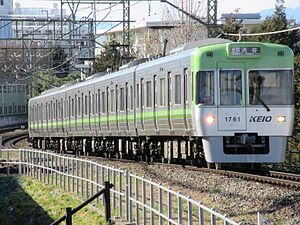Keio 1000 series
| Keio 1000 series | |
|---|---|

Green-liveried Keio Inokashira Line 1000 series set 1711 in January 2016
|
|
| In service | 1995-Present |
| Manufacturer | Tokyu Car Corp, Nippon Sharyo |
| Replaced | Keio 3000 series |
| Refurbishment | 2016–2020 |
| Number built | 145 vehicles (29 sets) |
| Number in service | 145 vehicles (29 sets) |
| Formation | 5 cars per trainset |
| Operator(s) | Keio Corporation |
| Depot(s) | Fujimigaoka Depot |
| Line(s) served | Keio Inokashira Line |
| Specifications | |
| Car body construction | Stainless steel |
| Car length | 20,000 mm (65 ft 7 in) |
| Width | 2,864 mm (9 ft 5 in) |
| Doors | 4 pairs per side |
| Maximum speed | 90 km/h (56 mph) |
| Acceleration | 2.6 km/h/s (batches 1-2) 3.3 km/h/s (batches 3-6) |
| Deceleration | 3.7 km/h/s (4.0 km/h/s for emergency brake) |
| Electric system(s) | 1,500 V DC |
| Current collection method | Overhead |
| Safety system(s) | ATS-SN |
| Track gauge | 1,067 mm (3 ft 6 in) |
The Keio 1000 series (京王1000系?) is a DC commuter electric multiple unit (EMU) train type operated by Keio Corporation in Tokyo, Japan.
As of 1 April 2016[update], the fleet consists of 29 five-car trainsets.
Sets 1701 to 1710. Formation consists of two motor and three trailer cars.
Sets 1711 to 1715. Formation consists of three motor and two trailer cars. Raised driver's position.
Sets 1721 to 1734. Formation consists of three motor and two trailer cars. Beadless stainless steel bodysides. Full-colour LED destination indicator panels. Interior 17-inch colour LCD information panels.
The first ten sets, 1701 to 1710, are formed as follows with two motored ("M") cars and three non-powered trailer ("T") cars, and car 1 at the Kichijoji (western) end.
Cars 2, 3, and 4 each have one single-arm pantograph. Car 3 is designated a mildly air-conditioned car. Car 1 has a wheelchair space.
The refurbished sets are formed as follows with three motored ("M") cars and two non-powered trailer ("T") cars, and car 1 at the Kichijoji (western) end.
Cars 2, 3, and 4 each have one single-arm pantograph.
Sets 1711 to 1734 are formed as follows with three motored ("M") cars and two non-powered trailer ("T") cars, and car 1 at the Kichijoji (western) end.
Cars 2, 3, and 4 each have one single-arm pantograph. Car 3 is designated a mildly air-conditioned car. Car 1 has a wheelchair space.
The 1000 series were initially built by Tokyu Car Corp. The type was introduced in 1995, and was the first new rolling stock introduced on the Keio Inokashira Line in 33 years, after the 3000 series of 1962. It was the first type on the Inokashira Line to feature 20 m cars with four pairs of doors per side.
Third-batch sets from 1711 onward, built from 2003, incorporate system and interior modifications.
...
Wikipedia
